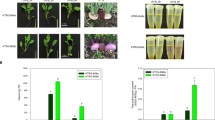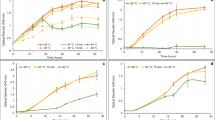Abstract
Exogenous elicitors can influence accumulation of triterpenoids by regulating FPS (farnesyl pyrophosphate synthase) in Inonotus obliquus, such as birch bark (BB), birch rhizosphere soil (BS), Frankia alni (FA), and Rhizobium indigoferae (RI). Among them, the highest yield of biomass (15.6 mg/mL) could be detected by treatment with RI at 2 µg/mL for 10 d, about 2.1-fold of the control. Results showed the significant effect of elicitors on accumulation of triterpenoids by regulating FPS expression level. RI stimulated mycelium to achieve the highest accumulation of triterpenoids about 48.2 mg/g, which was about over 4-fold of the control (9.5 mg/g). Its effect on FPS expression level was greater than that of others, which was about over 10-fold of the control. However, accumulation of triterpenoids and FPS expression level were clearly down-regulated under treatment with BS. In addition, two endogenous factors (H2O2 and NO) in I. obliquus could affect accumulation of triterpenoids by regulating FPS expression level. Effect of RI on H2O2 and NO contents were higher than that of others, about 3.5-fold of the control. The minimum value of H2O2 content was detected by treatment with BS for 10 d, which was about 0.5-fold of the control. RI that assist with CAT (catalase) and SNP (sodium nitroprusside dehydrate) could stimulate triterpenoid contents to achieve highest accumulation, which was about 5.5-fold of the control. Fluctuation of H2O2 and NO content seems to play a pivotal role in accumulation of triterpenoids by regulating FPS expression level.
Similar content being viewed by others
References
Wasser, S. P. (2011) Current findings, future trends, and unsolved problems in studies of medicinal mushrooms. Appl. Microbiol. Biotechnol. 89: 1323–1332.
Patel, S. (2015) Emerging Bioresources with Nutraceutical and Pharmaceutical Prospects. 1st ed., pp. 115–126. Springer International Publishing, Cham, Switzerland.
Kim, Y. O., H. W. Park, J. H. Kim, J. Y. Lee, S. H. Moon, and C. S. Shin (2006) Anti-cancer effect and structural characterization of endo-polysaccharide from cultivated mycelia of Inonotus obliquus. Life Sci. 79: 72–80.
Zheng, W. F., Y. X. Zhao, M. M. Zhang, Z. J. Yin, C. F. Chen, and Z. W. Wei (2008) Phenolic compounds from Inonotus obliquus and their immune-stimulating effects. Mycosystema. 27: 574–581.
Yan, Z. F., Y. Yang, F. H. Tian, X. X. Mao, Y. Li, and C. T. Li (2014) Inhibitory and acceleratory effects of Inonotus obliquus on tyrosinase activity and melanin formation in B16 melanoma cells. Evid. Based Complement Alternat. Med. 2014: 259836.
Basile, A., S. Sorbo, S. Giordano, L. Ricciardi, S. Ferrara, D. Montesano, R. Castaldo Cobianchi, M. L. Vuotto, and L. Ferrara (2000) Antibacterial and allelopathic activity of extract from Castanea sativa leaves. Fitoterapia. 71: S110–S116.
Papadopoulou, K., R. E. Melton, M. Leggett, M. J. Daniels, and A. E. Osbourn (1999) Compromised disease resistance in saponin-deficient plants. Proc. Natl. Acad. Sci. USA. 96: 12923–12928.
Tava, A. and M. Odoardi (1996) Saponins from Medicago spp.: chemical characterization and biological activity against insects. pp. 97–109. In: G. R. Waller and K. Yamasaki (eds.). Saponins Used in Food and Agriculture. Springer, Boston, MA, USA.
Martin, D., D. Tholl, J. Gershenzon, and J. Bohlmann (2002) Methyl jasmonate induces traumatic resin ducts, terpenoid resin biosynthesis, and terpenoid accumulation in developing xylem of Norway spruce stems. Plant Physiol. 129: 1003–1018.
Zhang, Y., Z. X. Li, X. D. Yu, J. Fan, J. A. Pickett, H. D. Jones, J. J. Zhou, M. A. Birkert, J. Caulfield, J. A. Napier, G Y. Zhao, X. G. Cheng, Y. Shi, T. J. A. Bruce, and L. Q. Xia (2015) Molecular characterization of two isoforms of a farnesyl pyrophosphate synthase gene in wheat and their roles in sesquiterpene synthesis and inducible defence against aphid infestation. New Phytol. 206: 1101–1115.
Ali, M. B., K. W. Yu, E. J. Hahn, and K. Y. Paek (2006) Methyl jasmonate and salicylic acid elicitation induces ginsenosides accumulation, enzymatic and non-enzymatic antioxidant in suspension culture Panax ginseng roots in bioreactors. Plant Cell Rep. 25: 613–620.
Afkar, S., G. Karimzadeh, M. Jalali-Javaran, M. Sharifi, and M. Behmanesh (2013) Influence of methyl jasmonate on menthol production and gene expression in peppermint (Mentha X piperita L.). J Med. Plants Prod. 2: 75–82.
Xu, X., X. Zhang, and C. Chen (2016) Stimulated production of triterpenoids of Inonotus obliquus using methyl jasmonate and fatty acids. Ind. Crops Prod. 85: 49–57.
Benson, D. R. and W. B. Silvester (1993) Biology of Frankia strains, actinomycete symbionts of actinorhizal plants. Microbiol. Rev. 57: 293–319.
Wei, G. H., E. T. Wang, Z. Y. Tan, M. E. Zhu, and W. X. Chen (2002) Rhizobium indigoferae sp. nov. and Sinorhizobium kummerowiae sp. nov., respectively isolated from Indigofera spp. and Kummerowia stipulacea. Int. J. Syst. Evol. Microbiol. 52: 2231–2239.
Li, C. T., Y. Y. Diao, X. X. Mao, and Y. Li (2012) The affection factors of Tricholoma matsutake mycelial biomass in liquid fermentation. Mycosystema. 31: 229–234.
Zheng, W. F., Y. C. Dai, J. Sun, Y. X. Zhao, K. J. Miao, S. Y. Pan, M. M. Zhang, and J. C. Wei (2010) Metabonomic analysis on production of antioxidant secondary metabolites by two geographically isolated strains of Inonotus obliquus in submerged cultures. Mycosystema. 29: 897–910.
Liu, X., L. Zhu, J. Tan, X. Zhou, L. Xiao, X. Yang, and B. Wang (2014) Glucosidase inhibitory activity and antioxidant activity of flavonoid compound and triterpenoid compound from Agrimonia Pilosa Ledeb. BMC Complement Altern. Med. 14: 12.
Feria-Romero, I., E. Lazo, T. Ponce-Noyola, C. M. Cerda-García-Rojas, and A. C. Ramos-Valdivia (2005) Induced accumulation of oleanolic acid and ursolic acid in cell suspension cultures of Uncaria tomentosa. Biotechnol. Lett. 27: 839–843.
Hu, R., C. Fan, H. Li, Q. Zhang, and Y. F. Fu (2009) Evaluation of putative reference genes for gene expression normalization in soybean by quantitative real-time RT-PCR. BMC Mol. Biol. 10: 93.
Blondal, T., S. J. Nielsen, A. Baker, D. Andreasen, P. Mouritzen, M. W. Teilum, and I. K. Dahlsveen (2013) Assessing sample and miRNA profile quality in serum and plasma or other biofluids. Methods. 59: S1–S6.
Imai, T., B. E. Ubi, T. Saito, and T. Moriguchi (2014) Evaluation of reference genes for accurate normalization of gene expression for Real Time-Quantitative PCR in Pyrus pyrifolia using different tissue samples and seasonal conditions. PLoS One. 9: e86492.
Grover, A., G. Samuel, V. S. Bisaria, and D. Sundar (2013) Enhanced withanolide production by overexpression of squalene synthase in Withania somnifera. J. Biosci. Bioeng. 115: 680–685.
Foissner, I., D. Wendehenne, C. Langebartels, and J. Durner (2000) In vivo imaging of an elicitor-induced nitric oxide burst in tobacco. Plant J. 23: 817–824.
Lamotte, O., K. Gould, D. Lecourieux, A. Sequeira-Legrand, A. Lebrun-Garcia, J. Durner, A. Pugin, and D. Wendehenne (2004) Analysis of nitric oxide signaling functions in tobacco cells challenged by the elicitor cryptogein. Plant Physiol. 135: 516–529.
Ren, C. G. and C. C. Dai (2012) Jasmonic acid is involved in the signaling pathway for fungal endophyte-induced volatile oil accumulation of Atractylodes lancea plantlets. BMC Plant Biol. 12: 128.
Schwacke, R. and A. Hager (1992) Fungal elicitors induce a transient release of active oxygen species from cultured spruce cells that is dependent on Ca and protein-kinase activity. Planta. 187: 136–141.
Cunniff, P. A. (1995) Official Methods of Analysis of AOAC International. 16th ed., Method 923.03. AOAC International, Arlington, VA, USA.
Moorby, J. M. (2014) Relationship between the composition of fresh grass-based diets and the excretion of dietary nitrogen from dairy cows. Proceedings of the 25th General Meeting of the European Grassland Federation. September 7–11. Aberystwyth, Wales, UK.
Wan, J. Y., Y. Fan, Q. T. Yu, Y. Z. Ge, C. P. Yan, R. N. Alolga, P. Li, Z. H. Ma, and L. W. Qi (2015) Integrated evaluation of malonyl ginsenosides, amino acids and polysaccharides in fresh and processed ginseng. J. Pharm. Biomed. Anal. 107: 89–97.
Yan, Z. F., N. X. Liu, X. X. Mao, Y. Li, and C. T. Li (2014) Activation effects of polysaccharides of Flammulina velutipes mycorrhizae on the T lymphocyte immune function. J. Immunol. Res. 2014: 285421.
Caplen, N. J., S. Parrish, F. Imani, A. Fire, and R. A. Morgan (2001) Specific inhibition of gene expression by small double-stranded RNAs in invertebrate and vertebrate systems. Proc. Natl. Acad. Sci. USA. 98: 9742–9747.
Low, G K. C., A. M. Duffield, and P. R. Haddad (1982) Peak-splitting in reversed-phase, ion-pair high-performance liquid chromatography of sympathomimetic drugs and its probable mechanism. Chromatographia. 15: 289–296.
Elsaid, N., T. L. Jackson, M. Gunic, and S. Somavarapu (2012) Positively charged amphiphilic chitosan derivative for the transscleral delivery of rapamycin. Invest. Ophthalmol. Vis. Sci. 53: 8105–8111.
Bayraktar, M., E. Naziri, I. H. Akgun, F. Karabey, E. Ilhan, B. Akyol, E. Bedir, and A. Gurel (2016) Elicitor induced stevioside production, in vitro shoot growth, and biomass accumulation in micropropagated Stevia rebaudiana. Plant Cell Tiss. Organ. Cult. 127: 289–300.
Lindström, K., A. A. Aserse, and S. A. Mousavi (2015) Evolution and taxonomy of nitrogen-fixing organisms with emphasis on Rhizobia. pp. 21–38. In: F. J. de Bruijn (ed.). Biological Nitrogen Fixation. John Wiley & Sons, Inc, Hoboken, NJ, USA.
Fan, G. Z., X. D. Wang, X. C. Li, J. S. Fan, Q. L. Zhai, and Y. G. Zhan (2011) Effect of fungal elicitor on carbon and nitrogen status and triterpenoid production in cell suspension cultures of Betula platyphylla Suk. J. Med. Plants Res. 5: 5413–5422.
Wang, J., W. Gao, B. Zuo, L. Zhang, and L. Huang (2013) Effect of methyl jasmonate on the ginsenoside content of Panax ginseng adventitious root cultures and on the genes involved in triterpene biosynthesis. Res. Chem. Intermed. 39: 1973–1980.
Lee, M. W., H. Hur, K. C. Chang, T. S. Lee, K. H. Ka, and L. Jankovsky (2008) Introduction to distribution and ecology of sterile conks of Inonotus obliquus. Mycobiology. 36: 199–202.
He, Y., Q. Pu, K. He, J. Tan, J. Li, and Z. Zhao (2011) Optimization of liquid fermentation conditions of Antrodia cinnamomea producing triterpenoid by uniform design. Chin. J. Appl. Environ. Biol. 17: 901–906.
Acknowledgements
This work was financially supported by Research Program of State Key Laboratory of Food Science and Technology, Jiangnan University (NO. SKLF-ZZA-201906); Fundamental Research Funds for the Central Universities (No. JUSRP11968 and JUSRP11961)
Author information
Authors and Affiliations
Corresponding author
Ethics declarations
Conflict of Interest> The authors report no conflicts of interest. The authors alone are responsible for the content and writing of this article.
Ethical Statements Neither ethical approval nor informed consent was required for this study.
Additional information
Publisher’s Note Springer Nature remains neutral with regard to jurisdictional claims in published maps and institutional affiliations.
Rights and permissions
About this article
Cite this article
Lin, P., Yan, ZF. & Li, CT. Effects of Exogenous Elicitors on Triterpenoids Accumulation and Expression of Farnesyl Diphosphate Synthase Gene in Inonotus obliquus. Biotechnol Bioproc E 25, 580–588 (2020). https://doi.org/10.1007/s12257-019-0502-y
Received:
Revised:
Accepted:
Published:
Issue Date:
DOI: https://doi.org/10.1007/s12257-019-0502-y




